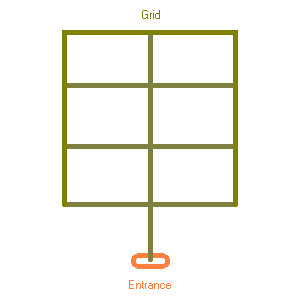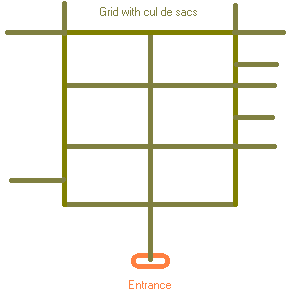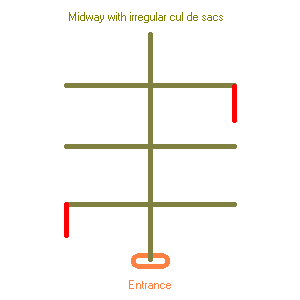By Fossil
Two of the most common questions at RCT forums are, "My peeps are stuck and can't find the exit" and "My park's rating has gone to zero."
Closer examination of the second question often reveals that the park rating had gone down because the peeps are stuck. In this article I will describe why peeps get stuck, and how you can build your parks' pathing systems to avoid this problem.
How peeps look for the exit
Once you understand how the AI directs peeps to the exit, it will be easy to understand when a path can cause problems.
A path without corners has one direction that takes a peep closer to the exit, and one direction that takes a peep farther away (exception: the point that crosses horizontally in front of the exit - don't worry about those). A peep intending to leave the park "wants" to go towards the exit, and given a chance, will head in the "proper" direction. However peeps' "look ahead" capability is exactly zero. It only knows the directions available from the tile that it is standing on.
Peeps don't change their minds about direction every step of the way. They make the choice at path "decision points." The decision points are:
- Path intersections
- Ride entrances and exits
- Shops and stalls
- Benches (to a minor degree)
Often they will walk past a decision point without making a decision - they don't "notice" it, and continue on their way.
A peep heading towards the exit that does notice the decision point will usually choose the presumed direction of the exit, cleverly factoring only the path it is standing on in the decision process.
A path can be very twisted and irregular without causing problems - as long as there are no decision points.
How peeps find a ride
A peep with a map can locate a ride or attraction. It uses the same logic for traveling there as a peep heading for the exit. The difference is that there is little consequence to the park's rating if a peep can't find the ride. The peep will give up looking after awhile, and look for something else.
Therefore, the most important consideration in designing your paths is to make sure that peeps can find the exit.
Two approaches to pathing systems that work well are the Midway and the Regular Loop. Ultimately, both can lead to grids in a fully-built park.
The Midway
The simplest pathing system is a midway that runs straight into your park from the entrance. Without turns, no confusion occurs among either the guests or staff. This is a great way to start building paths in any new park.
Scenarios such as Fungus Woods, that begin with a somewhat twisted path, invite you to build an inferior pathing system. I recommend demolishing twisted paths when you start a scenario.
Branching from the Midway

Branches from a Midway will not cause problems for peeps exiting the park. It is a natural second step for a Midway pathing system.
The Midway becomes a grid

The third step in the evolution of the Midway pathing system is adding additional front-to-back paths, making your park into a grid resembling city blocks. This is a very effective system.
Mechanics may get hung up in a grid, attempting to use ride exit and entrance paths instead of the "real" paths. For this reason, mechanics will usually require patrol routes in a grid system.
Branching off from the grid

You can continue building additional city blocks in your grid. Once you approach the park boundaries, you can add cul-de-sacs where convenient. In each one, add a ride and a stall or two. This helps disperse the crowds, minimizing the "park is too crowded" thought.
The Regular Loop

Loops are more complex, especially when they have many corners. Consider the path at points A, B, and C. Let's assume that all three points are "decision points." At point "A", both directions lead away (farther from) from the park exit. At point "B", one direction is towards the exit, and one direction is away from it. At point "C", both directions lead toward the exit.
Only at decision point "B" can a peep in search of the exit unambiguously make a "correct" choice.
Fortunately, wrong decisions at "A" or "C" are not all that harmful, because both directions will ultimately lead our peep to the exit, and the long way to the exit is not too much longer than the short way.
Regular loops generally will not result in stuck peeps. Once in awhile a peep may traverse along the far edge of the park for quite some time, making the "wrong" choices at decision points similar to "A" and C." This is different from the massive systemic breakdown that causes a park rating to drop to zero.
The Irregular Loop

The red area of the path is the irregular portion. Peeps will get stuck in the red area of this path. The decision points in the vertical sections of the red area will cause a peep seeking to exit to endlessly traverse this part of the path.
Irregular branches

The red areas are again peep death-traps if they have decision points. Peeps heading toward the exits may head down these dead-ends, then never escape.
Conclusion
Build your paths so your peeps can find their way home, and they will show their appreciation by giving your park "two thumbs up!"